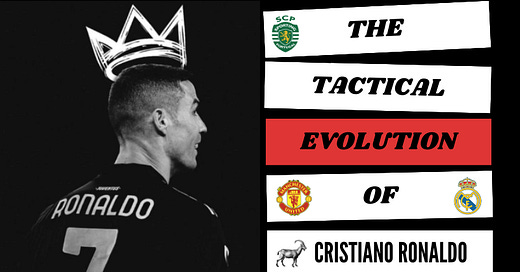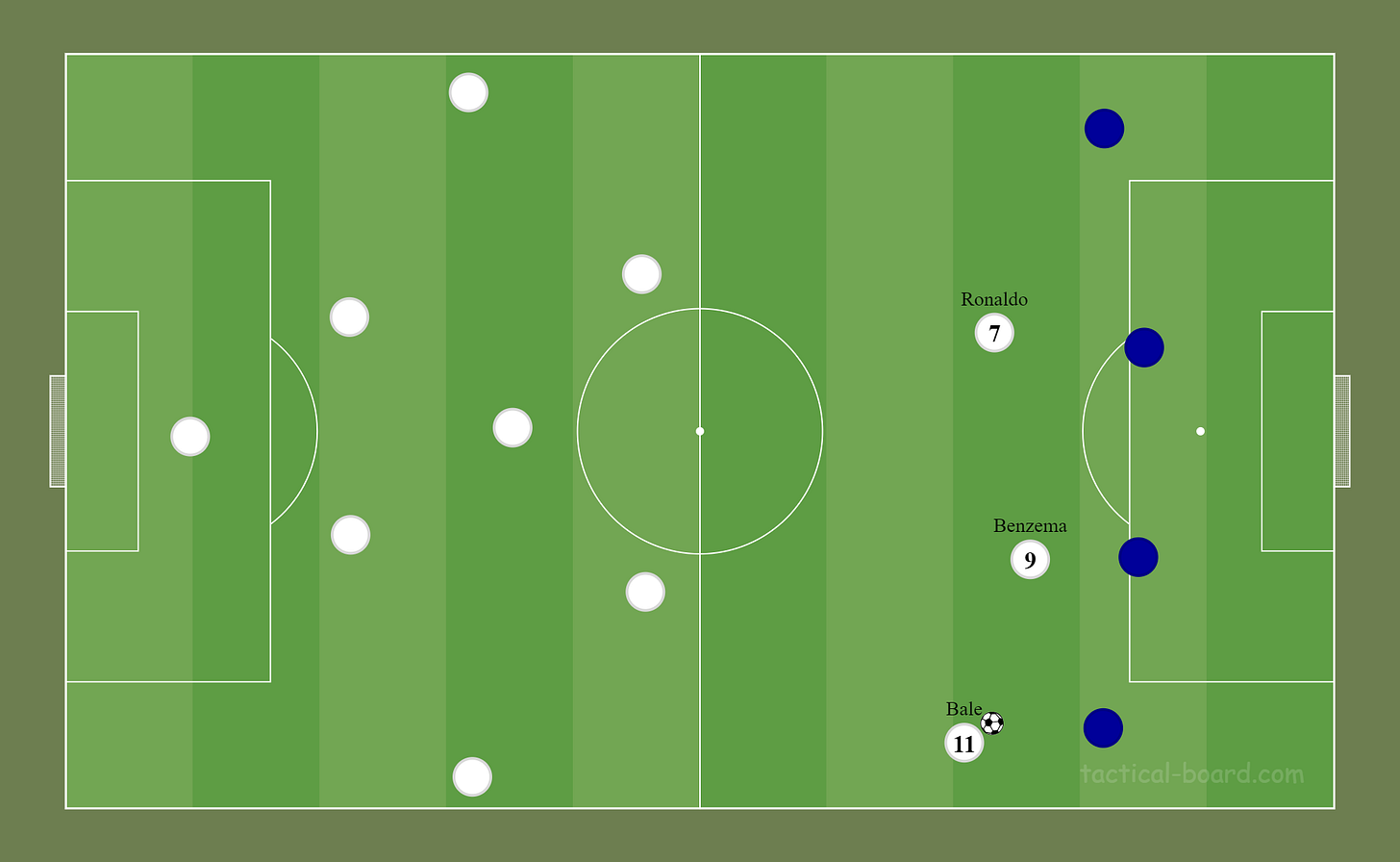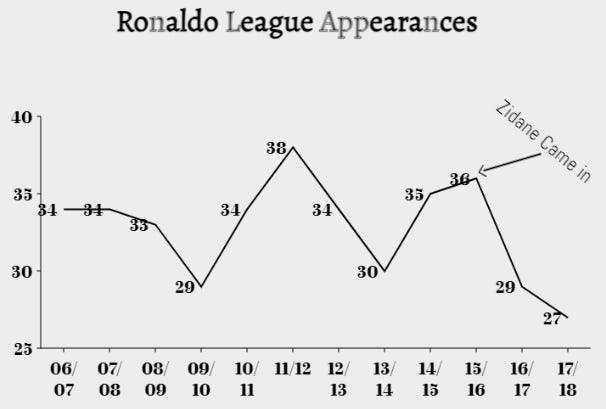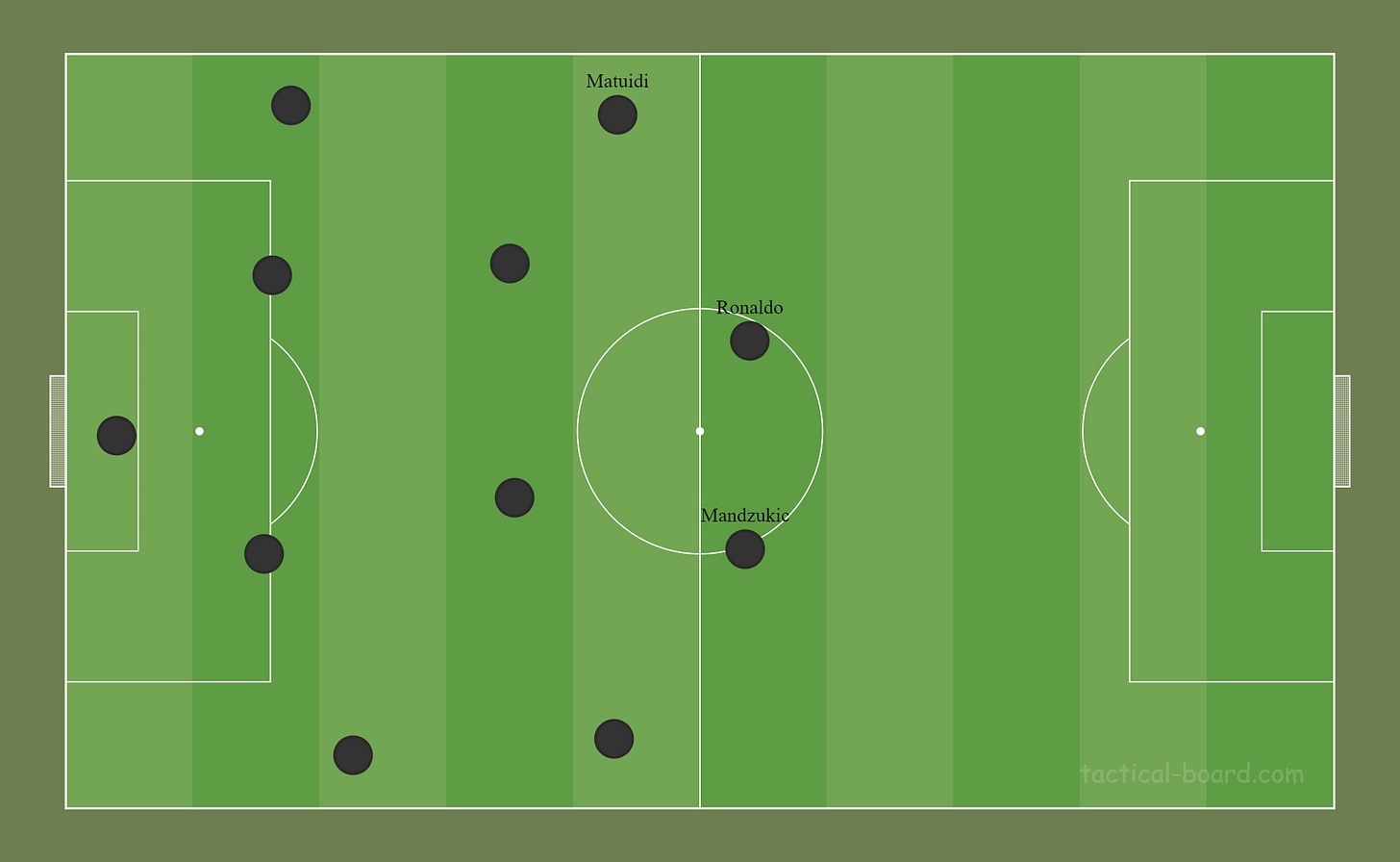"I see football as mission: go to the field, win, make myself better" Cristiano Ronaldo
Nobody can doubt that Cristiano Ronaldo is one of the greatest footballers of all time, if not the best. He has been an iconic player over his career with Manchester United, Real Madrid, Juventus and now with Al Nasr.
But the question here is: How did Cristiano Ronaldo change his tactical role through his career as he was reaching milestones?
Let’s dug into it.
𝗦𝗽𝗼𝗿𝘁𝗶𝗻𝗴 𝗟𝗶𝘀𝗯𝗼𝗻: 𝗕𝗶𝗿𝘁𝗵 𝗼𝗳 𝗮 𝗧𝗮𝗹𝗲𝗻𝘁
With his pace, dribbling abilities, Ronaldo broke through in Sporting Lisbon first team at just 17. He was one of the best talents in the world that many clubs like Arsenal, Manchester United were putting an eye on him.
Ronaldo was a right-footed winger, attacking the byline and looking to cross. However, he was criticized for not turning his capabilities into goals or assists as he scored only 3 league goals in 25 appearances.
In 2003, Manchester United faced Sporting Lisbon in the inauguration of Estádio José Alvalade, as it was the game that made Sir Alex Ferguson brought the 18 years old straightaway to Old Trafford after he performed magnificently against the red devils.
“I saw how good Ronaldo was that day. He was up against John O’Shea. Sheasy ended up seeing the doctor at half-time because he was actually having dizzy spells.” Roy Keane former Manchester United Captain in his autobiography.
𝗠𝗮𝗻𝗰𝗵𝗲𝘀𝘁𝗲𝗿 𝗨𝗻𝗶𝘁𝗲𝗱: 𝟮𝟬𝟬𝟯-𝟮𝟬𝟬𝟵
The 2006 world cup was a separator between two versions of Cristiano Ronaldo. In fact, when CR7 came in, he played again as a traditional right winger in Fergusson 4-4-2. Cristiano didn’t reach his potential as planned. He was still a “Show Pony” and ineffective. Ronaldo extra-dribbling made his senior teammates frustrated with his selfish attitude in the pitch: "Why doesn't he just bollock it!?" Gary Neville said. As a result, he recorded 0.26 goal and 0.2 assist per game.
After 2006 world cup, Cristiano came back different. “That was the moment you knew he was going to be special - I've never seen anything like it” Gary Neville says 2006 World Cup was a life changer for Cristiano Ronaldo at Manchester United, claiming “all the negative aspects of his game just disappeared”. The lad turned into a beast physically and mentally. Cristiano developed his game, was less showboating and more clinical after Sir Alex Fergusson gave him more positional freedom drifting infield more often.
In 2007, Tevez joined Manchester United. Wayne Rooney and Carlos Tevez being unorthodox strikers alongside with Ronaldo, the manager allowed them fluidity to interchange positions and consequently they can find spaces to attack. In 2008, Sir Alex Fergusson added the Bulgarian Dimitar Berbatov to the squad as centre-forward. The latter had a mission to find spaces deeper.
As Part of his development, Ronaldo exploited his aerial ability making him override his xG that was amounted to 3.03 and score eight league headers. Coming to shots, Cristiano took on 527 which 60% of them were launched from 21 yards out.
During that period, Manchester United won three consecutive premier leagues, guaranteed a UEFA champions league title in 2008 and were the runners-up in 2009.
𝗥𝗲𝗮𝗹 𝗠𝗮𝗱𝗿𝗶𝗱: 𝟮𝟬𝟬𝟵-𝟮𝟬𝟭𝟴
Cristiano Ronaldo passed through 3 tactical shapes during his time at Santiago Bernabéu.
𝙹𝚘𝚜𝚎́ 𝙼𝚘𝚞𝚛𝚒𝚗𝚑𝚘 𝚊𝚗𝚍 𝙼𝚊𝚗𝚞𝚎𝚕 𝙿𝚎𝚕𝚕𝚎𝚐𝚛𝚒𝚗𝚒 𝟺-𝟸-𝟹-𝟷:
In this Period, Ángel Di María was occupying the right side, Kaká or Mesut Özil were operating as center attacking midfielders, Gonzalo Higuaín or Karim Benzema were playing as strikers and Ronaldo was in the left wing trying to cut inside and shoot.
To elaborate more, Kaká then Mesut Özil would draw defenders away to open spaces for Cristiano and attack centrally with dribbles and shots. In addition, when the ball went wide, CR7 was attacking the box to receive service and score. Ronaldo was contributing to open spaces for Ozil when he drew defenders out to the left.
When Real Madrid were defending, he would only drop down if they were under pressure in a 4-4-2 diamond shape. This approach gave birth to one of the best counter-attacking teams the game has ever seen.
𝚁𝚎𝚊𝚕 𝙼𝚊𝚍𝚛𝚒𝚍 𝙲𝚊𝚛𝚕𝚘 𝙰𝚗𝚌𝚎𝚕𝚘𝚝𝚝𝚒 𝚊𝚗𝚍 𝚉𝚒𝚗𝚎𝚍𝚒𝚗𝚎 𝚉𝚒𝚍𝚊𝚗𝚎 :
In 2013, Kaká, Mesut Özil and Gonzalo Higuaín were sold to AC Milan, Arsenal and Napoli respectively. Gareth Bale came in from Tottenham to operate on the right wing and maintain the width and Karim Benzema as a pure center-forward.
With a hardworking midfield composed of Luka Modrić, Xabi Alonso and Ángel Di María, Bale being wide and attracting defenders out allowed Cristiano to become more of a fixture in the box. According to numbers, Ronaldo shot more from inside 21 yards than outside and scored 38 non-penalty goal in 2013/2014 season.
Ronaldo Improved his finishing ability, his movement inside the box and his work without the ball made him finish the 2014-2015 season with 61 goals of which 38 came from open play.
With the arriving of Zinedine Zidane in the mid of 2015/2016 season, Real Madrid shifted to 4-4-2 diamond with Cristiano Ronaldo and Karim Benzema up top as a strikers and Isco was behind them. CR7 started higher, dropping only for attacking link up. He played the last shoulder to get through balls moving and lurking in the box for crosses.




In 2016/2017, he scored 19 goals in La Liga from open play and had 23 the next year as his lowest totals since his arrival at the Bernabéu. His shots also went down to 5.88 over the two years. In addition, his dribbling effectiveness has dropped as he has succeeded to take players on 0.99 times per 2.39 attempts. Those previous numbers don’t mean Ronaldo was in a decline. However, Cristiano Ronaldo number of games has dropped by agreement with Zinedine Zidane to keep him fresh for the big games.
𝗝𝘂𝘃𝗲𝗻𝘁𝘂𝘀: 𝟮𝟬𝟭𝟴-𝟮𝟬𝟮𝟭
Allegri was opting for 4-3-3 turned often into 4-2-2 with Matuidi out wide at the left. Mario Mandžukić played alongside with Ronaldo as he was a reference point granting to him the positional freedom to choose where he wants to operate.
In fact, he was more contributing to team build up play, coming deeper as Juventus liked to stay in their areas most of the time. In that system, Ronaldo’s passes rate went up from 27 in 2017/18 to 33 pass per game in 2018/19. Moreover, His dribbling attempts jumped from 1.9 to 2.7 per game.
Allegri is an advocate of wide overloads, using his wingback Alex Sandro to form a partnership with Ronaldo and Matuidi. The pair making runs and drawing the opposition attention gave Cristiano space to shoot or look for crosses. Adding to that, Ronaldo long balls have risen as he has made more ball switches from wide areas.


Ronaldo’s eager to score made him drift into the box. And that’s why Mandžukić played most of the time alongside with him. He was able to adapt to play wide left when Ronaldo came central.
Statistics proved Ronaldo retransition from a box penalty forward into a versatile player. In fact, his offsides per game went down as his passes, dribbles attempted and shots outside the box per game went up.
Finally, Cristiano Ronaldo has been always successful to adapt himself to different styles of play adopted by numerous coaches whom he was under their management, from a right winger to a left winger to a penalty box forward.









